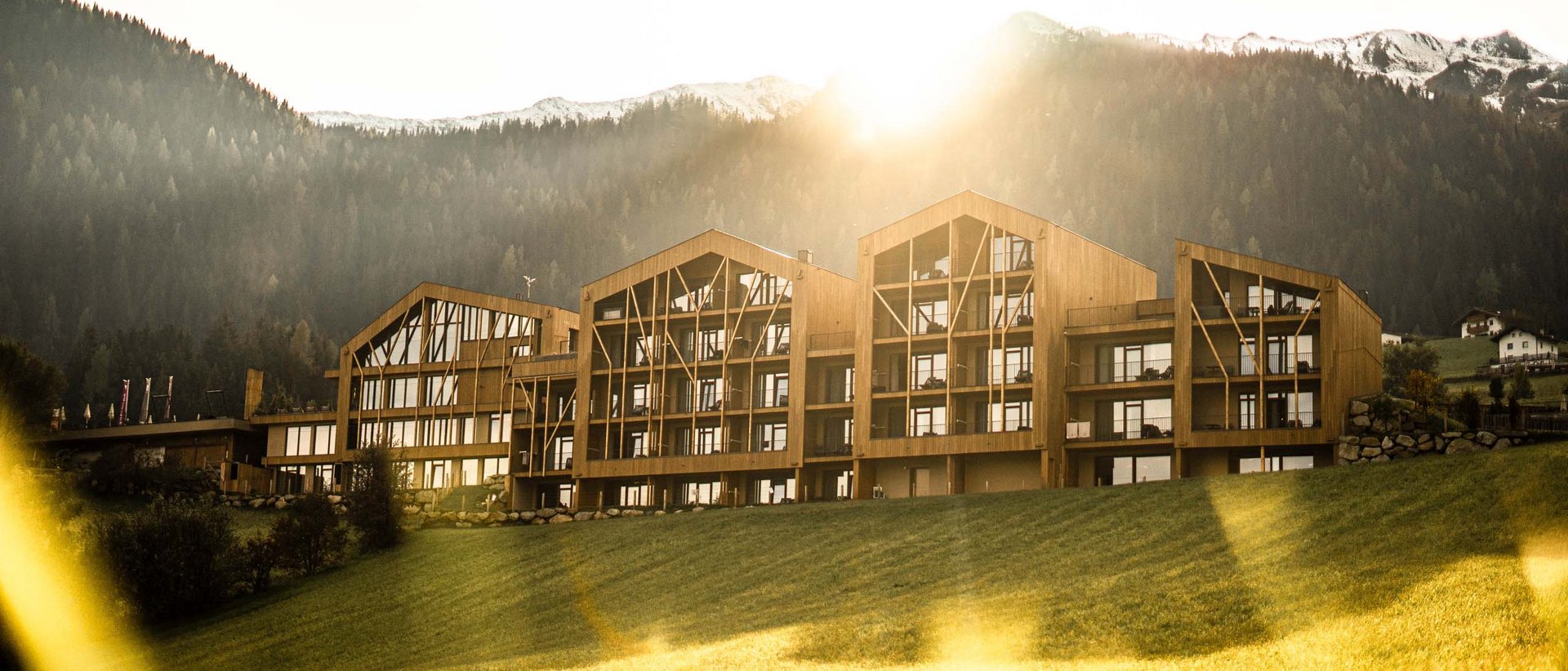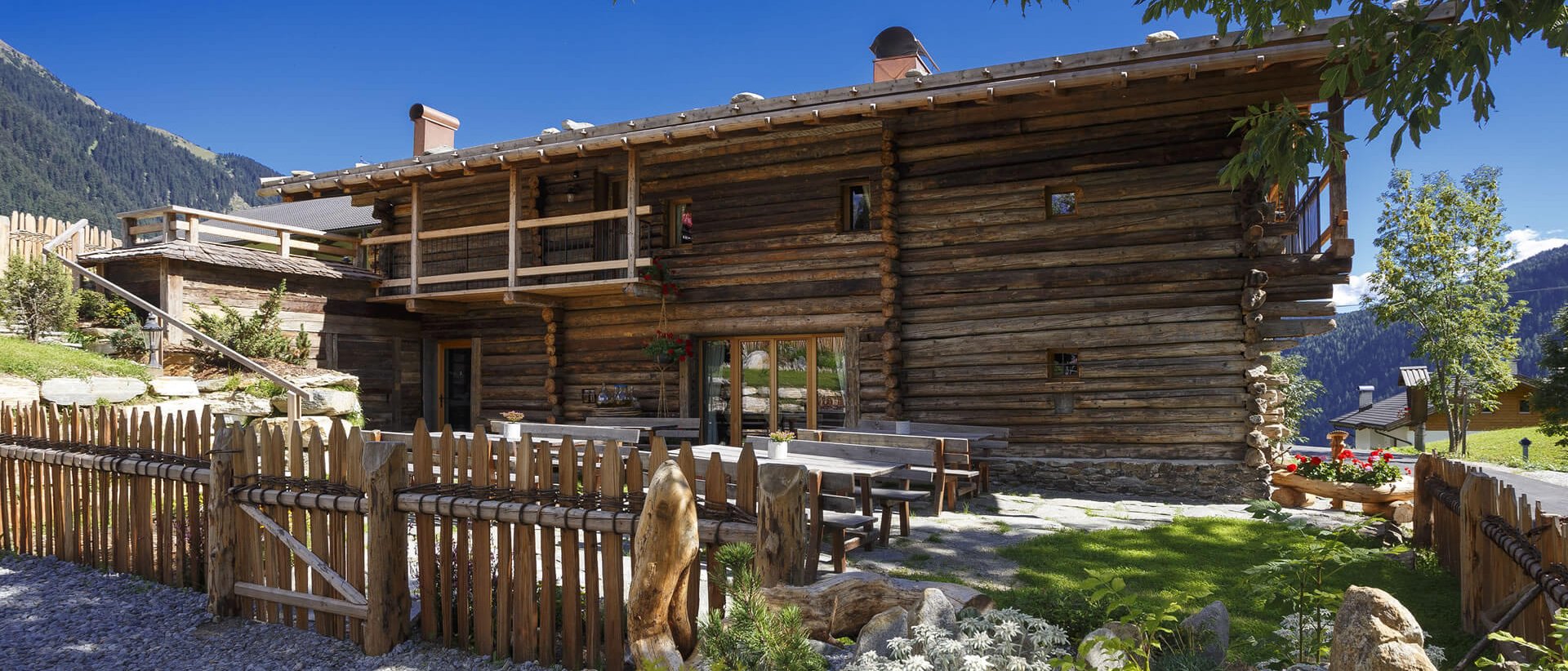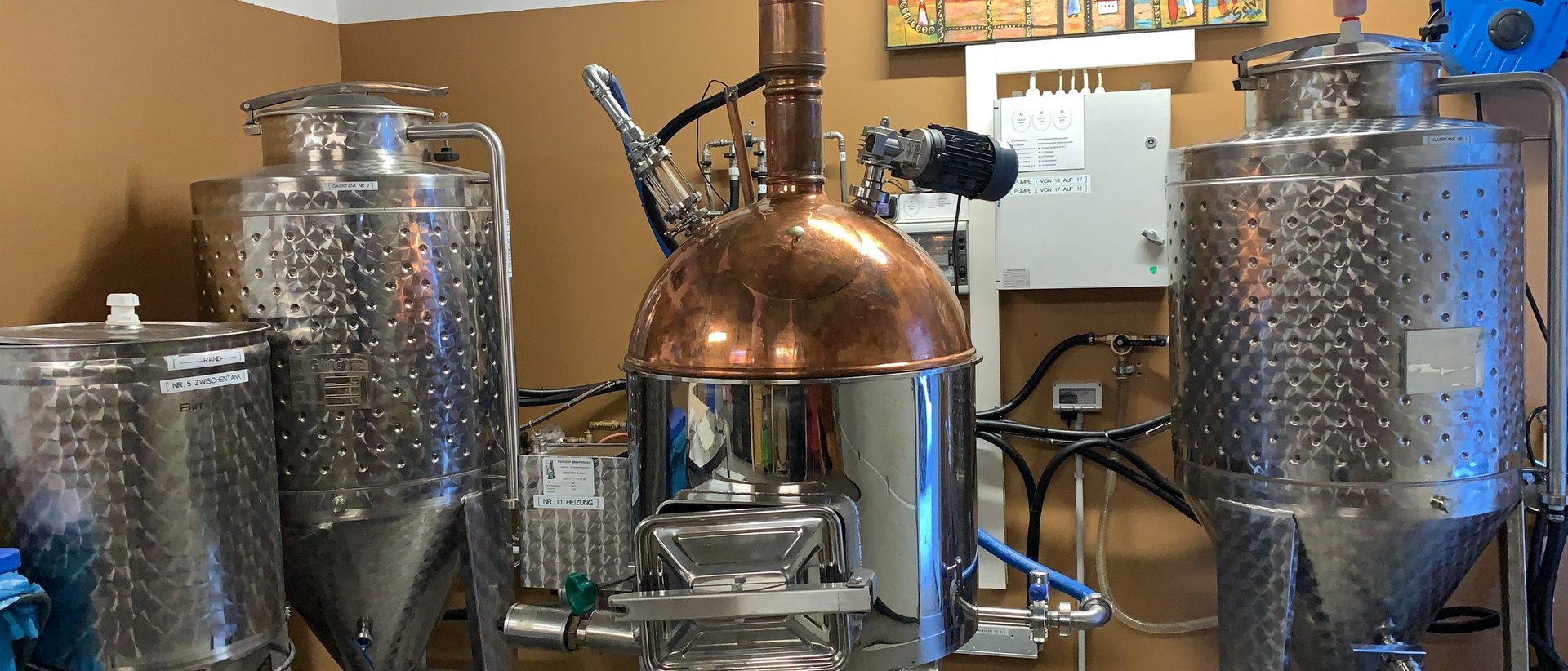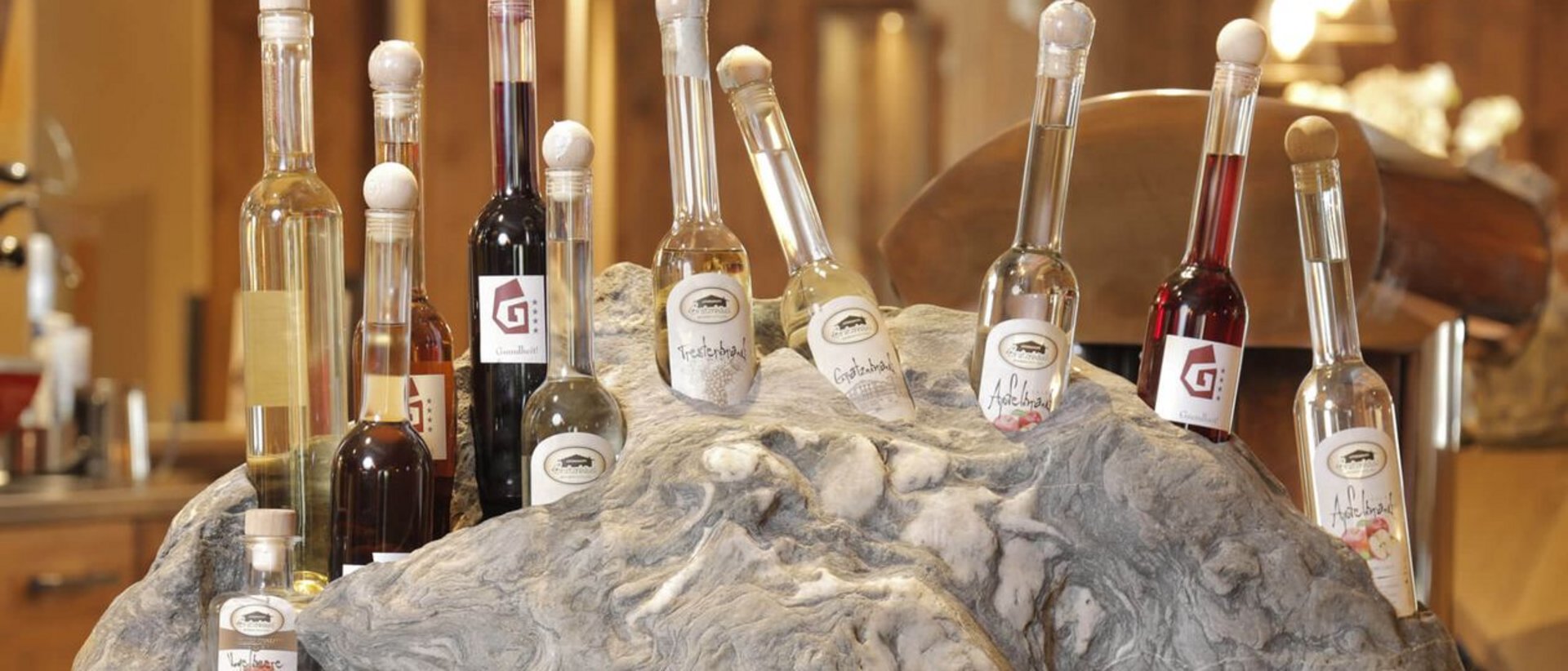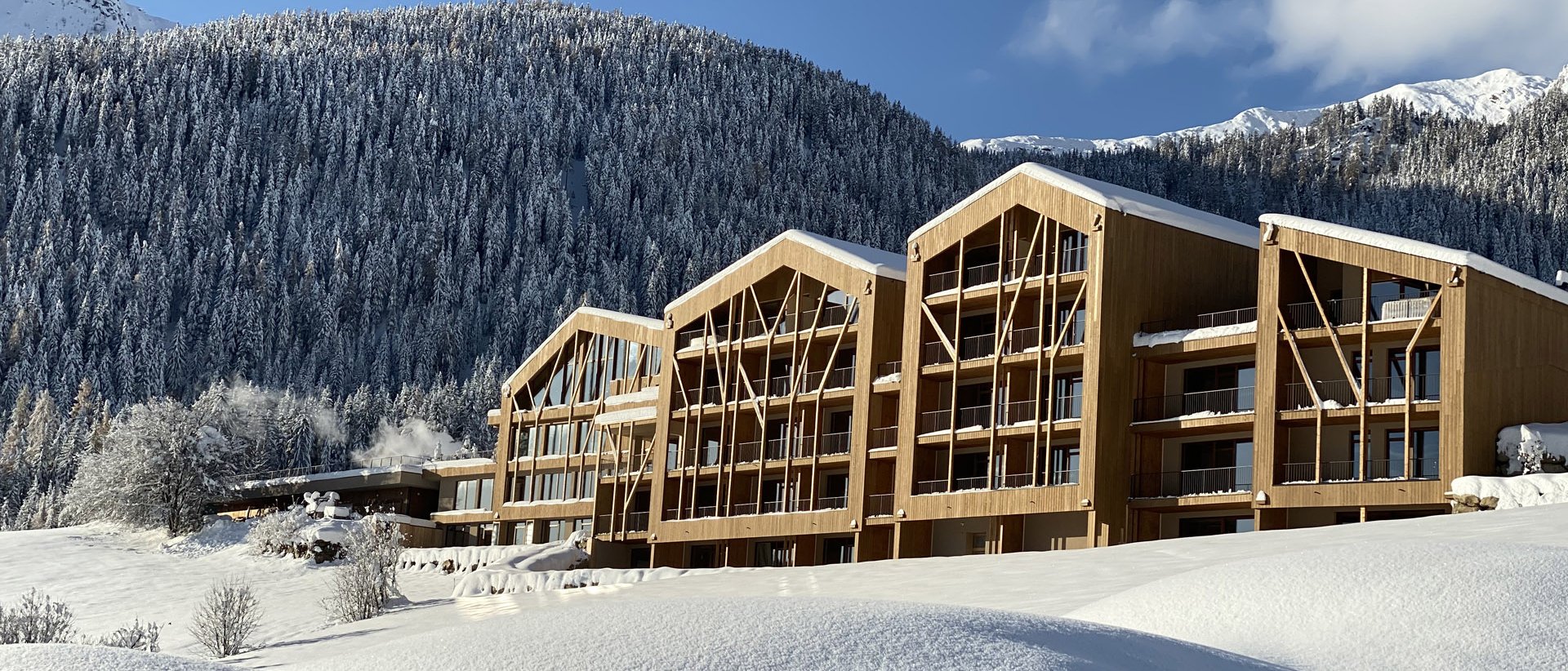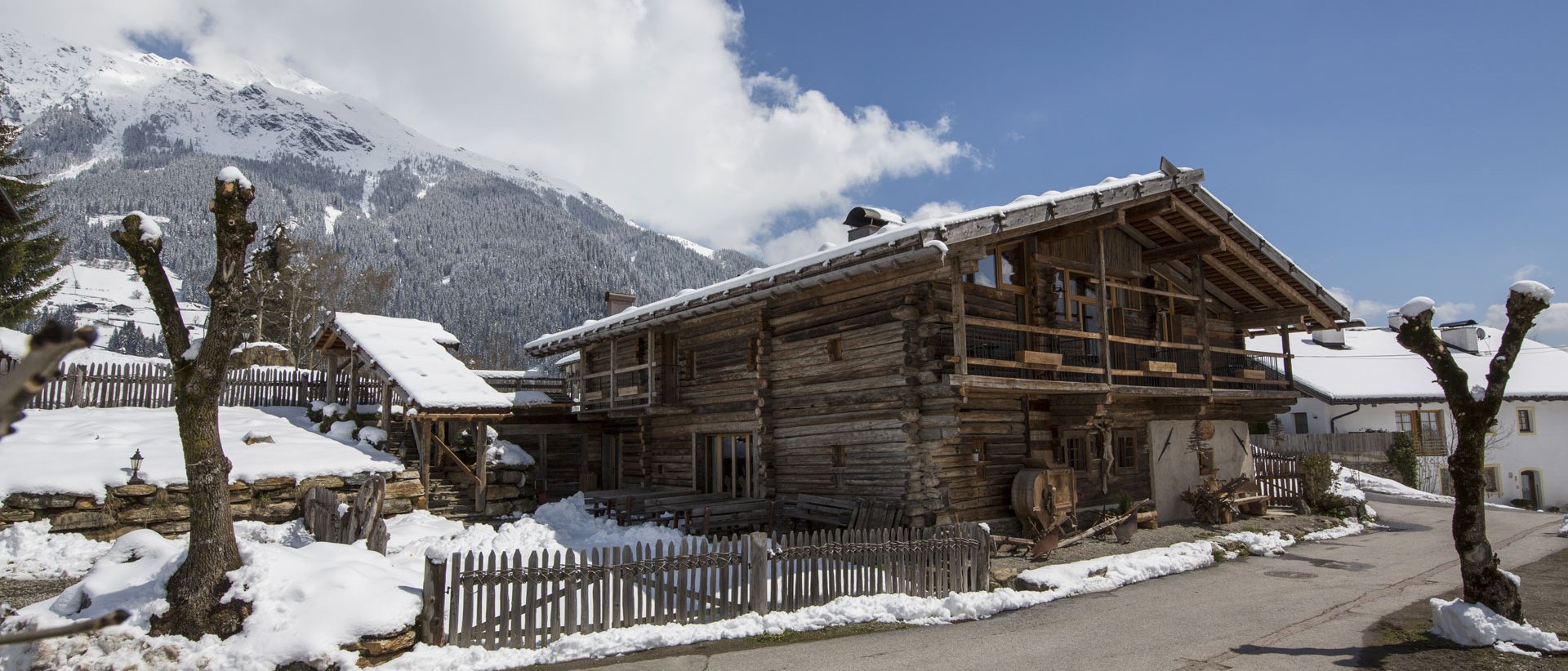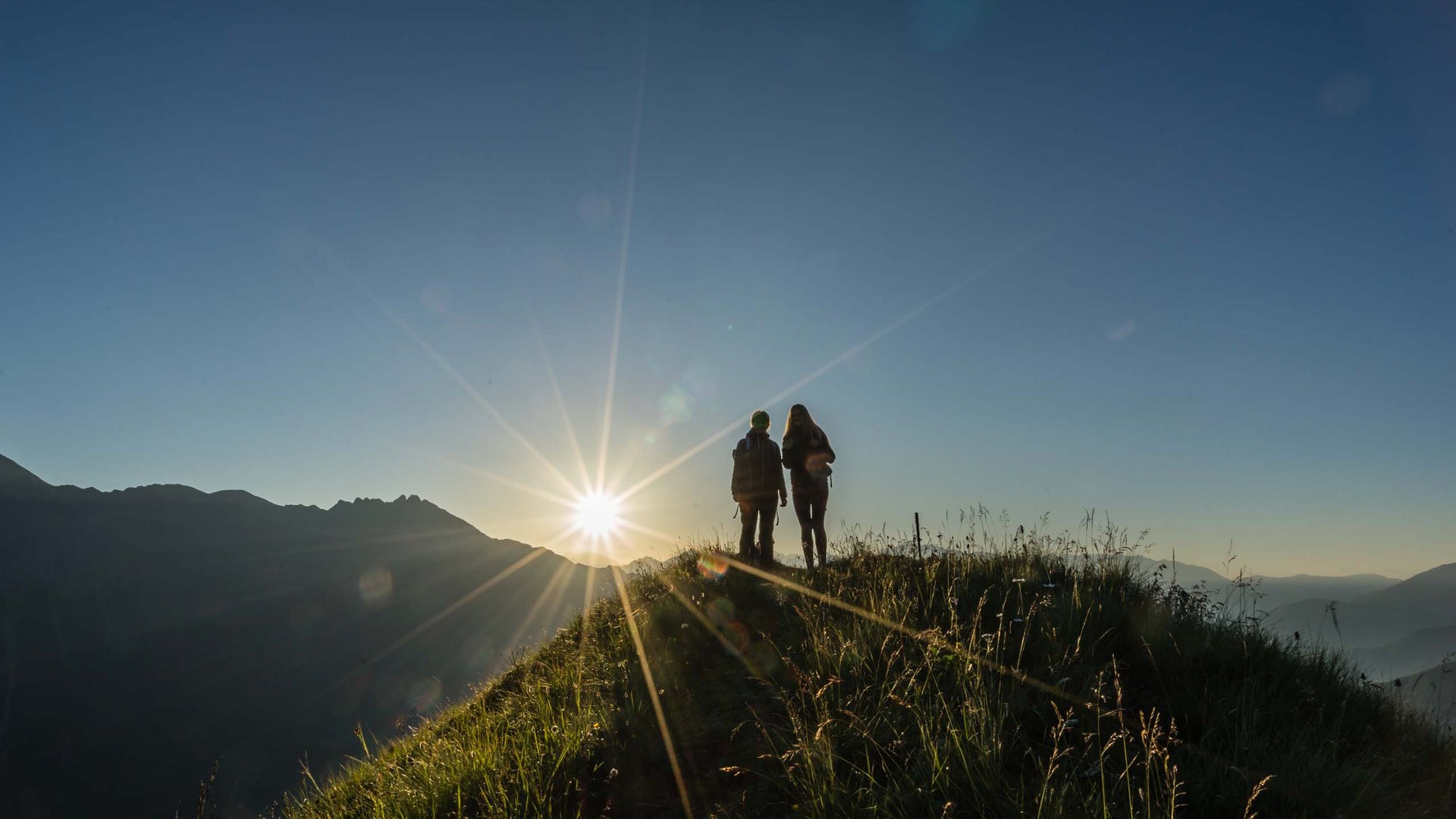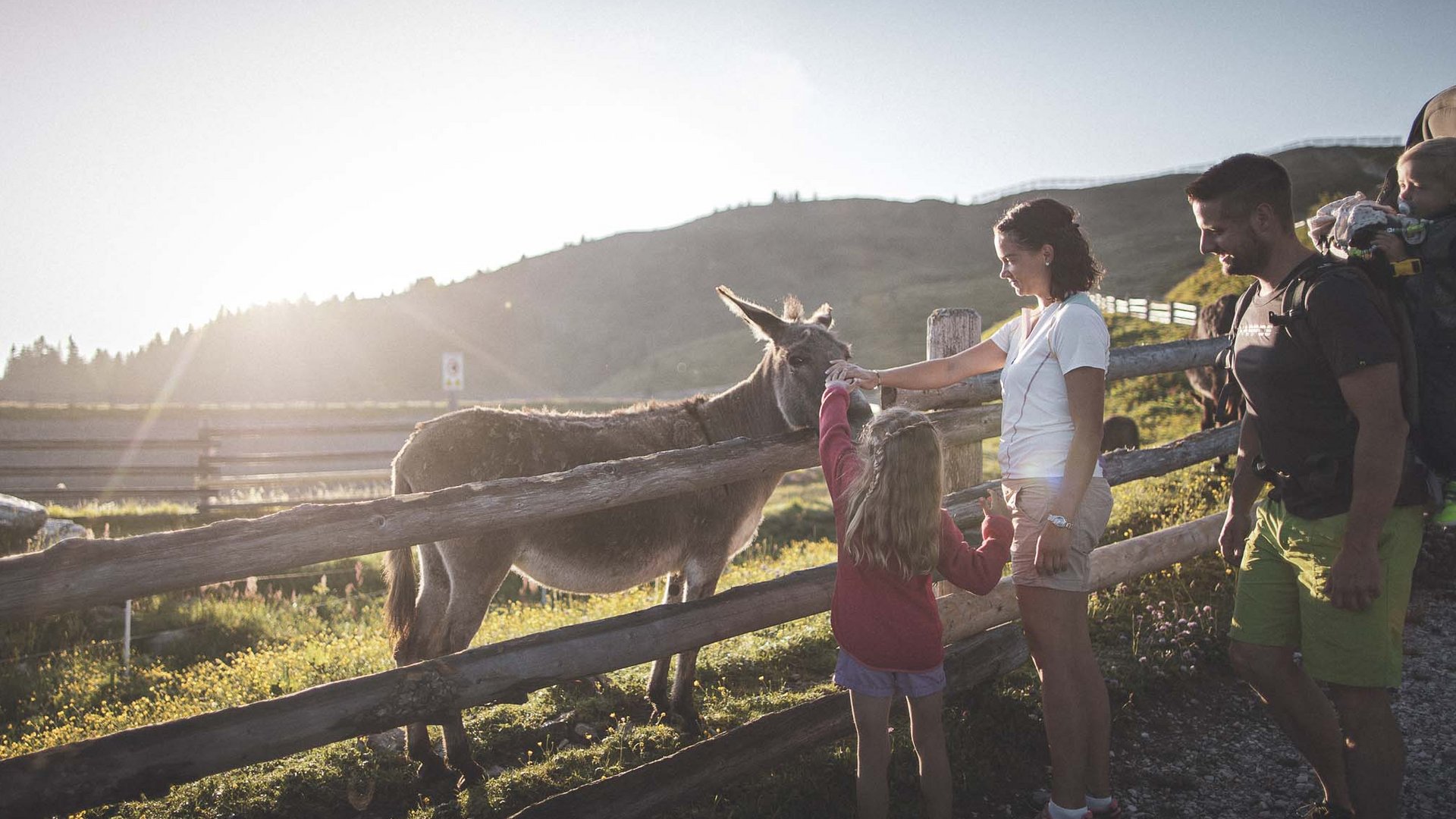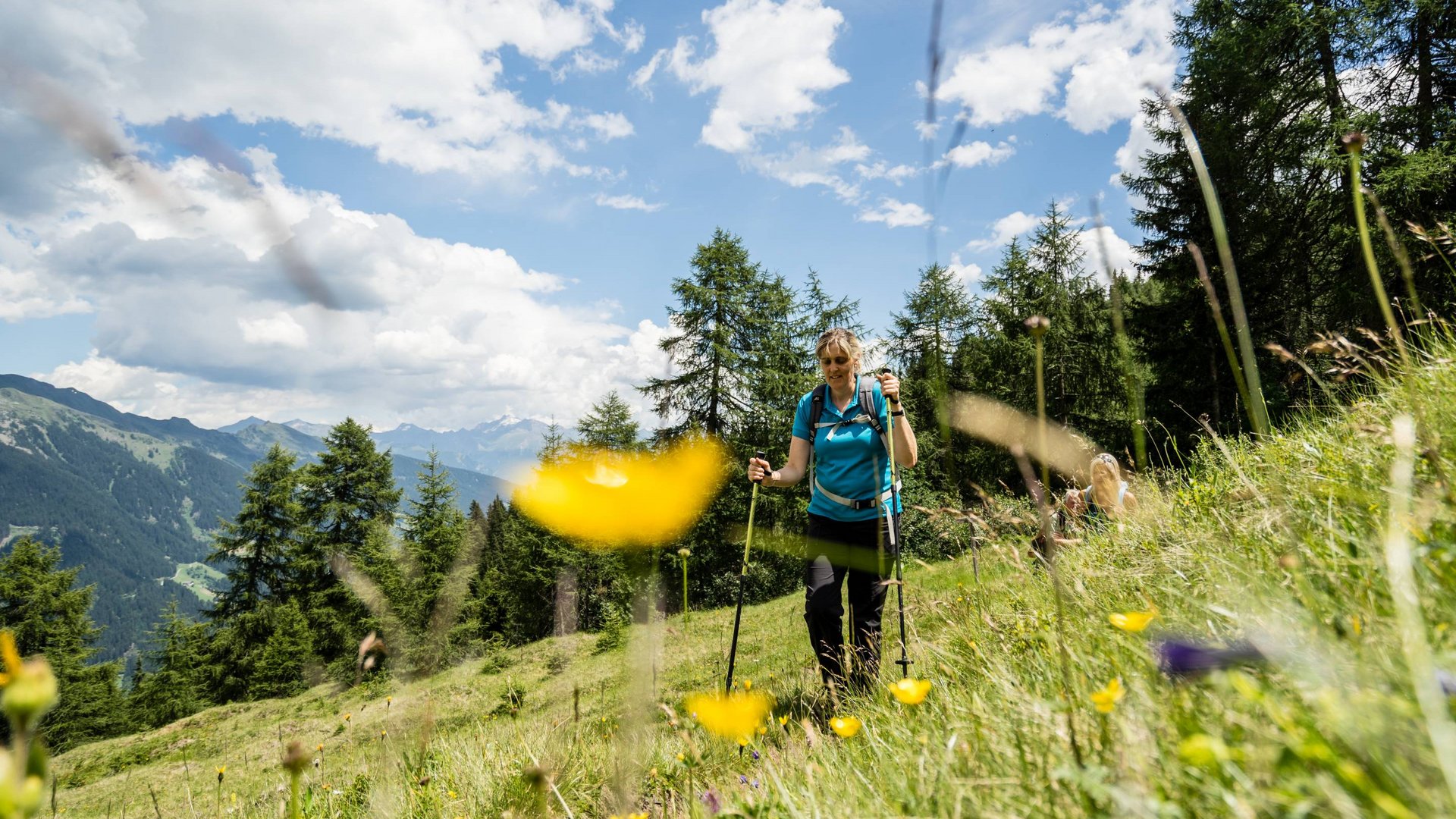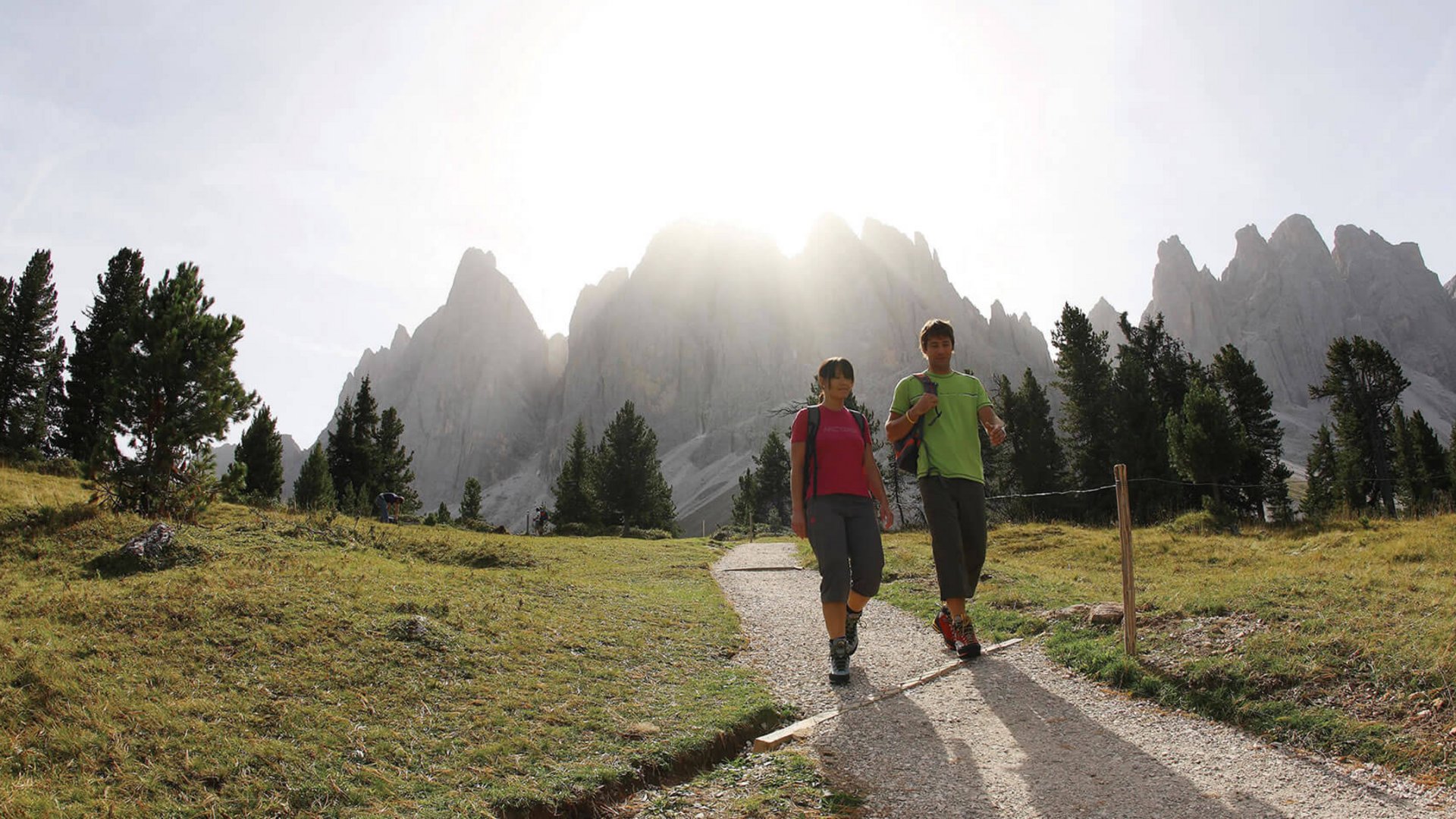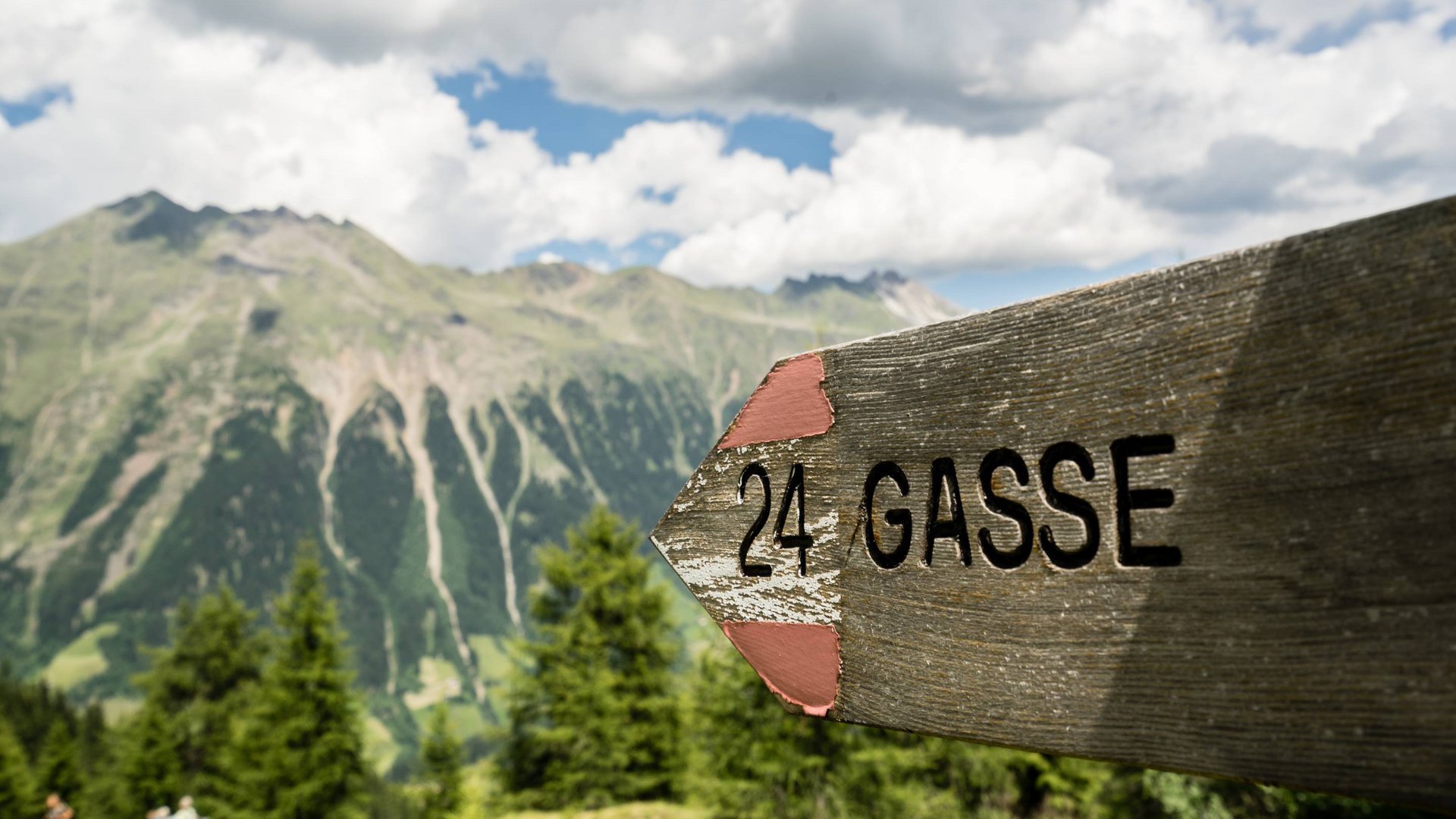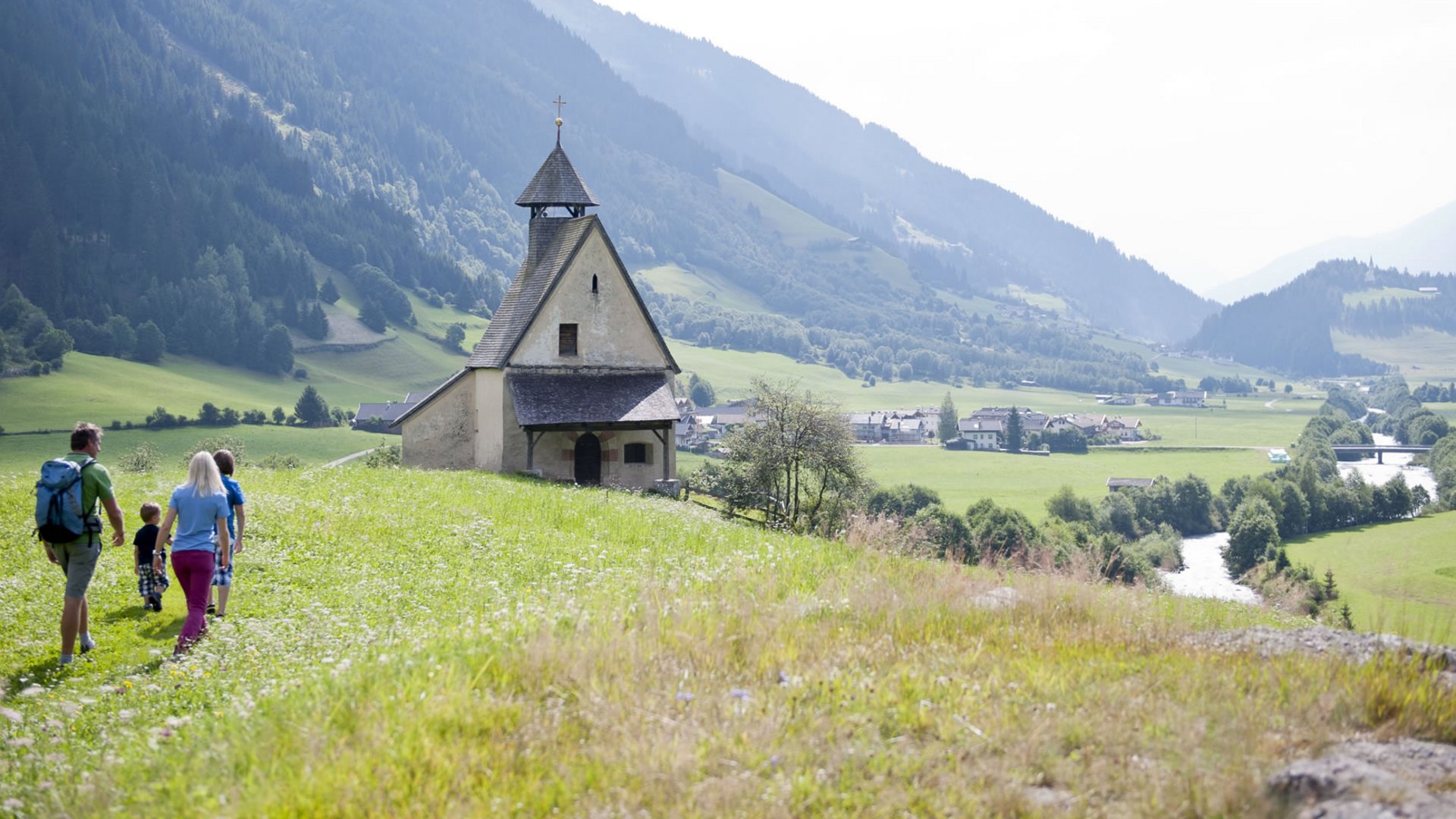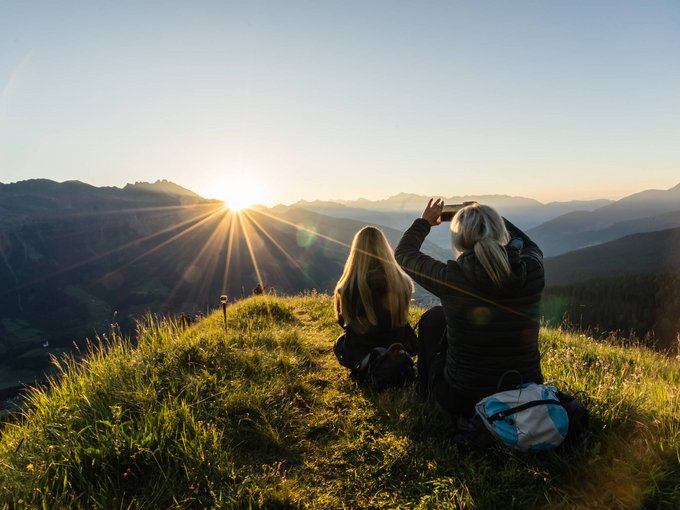Are you ready for memorable hikes in the South Tyrolean mountains?
Our recommended routes in the Ridnauntal valley
Easy, intermediate or challenging – how do you like your hike? On your hiking holiday in South Tyrol, you can take your pick from a variety of inspiring paths, trails and itineraries. To help you navigate the wide choice, we have listed here below the most spectacular routes near our Wanderhotel:
Easy excursions
Wildn Alm
1.5 hours – 460 m elevation gain – 3.5 km
Every week, we invite our guests to hike with us to Wildn Alm – the hotel’s own hut. We will depart together on foot directly from Erlebnisort Gassenhof, and tackle the 3.5 km to the hut, a walk that takes about 1.5 hours and involves just under 500 metres of elevation gain and. On arrival, you will be rewarded with a fantastic view and a hearty meal consisting of traditional cold cuts and cheese and Kaiserschmarrn, freshly prepared by the owner Manni himself.
St. Magdalena chapel
0.5 hours – 70 m elevation gain – 1.5 km
Starting directly from Erlebnisort Gassenhof, an easy path leads gently into the valley, with a small climb to one of the landmarks of the Ridnauntal valley: the St. Magdalena chapel. It was built at the end of the 15th century by the Schneeberg miners, and features four late Gothic altars that are well worth seeing.
Gilfenklamm gorge – Reifenegg ruins
2 hours – 300 m elevation gain – 5.5 km
From Erlebnisort Gassenhof, drive for 6 km down the valley to the Gilfenklamm car park, in the locality of Stange. From there, follow the signs to the Gilfenklamm gorge. The white marble cliffs have been carved by the clear water of the Ratschings stream for thousands of years, creating South Tyrol’s most beautiful gorge. Over a series of bridges, footbridges and stone steps, the path takes you deep into the gorge and its thundering waterfall. After about 500 metres, you will reach the end of the gorge and the adjacent Jaufennegg inn. From there, going a little further into the valley, the path turns left into the woods. After another 45 minutes, you will find yourself standing before the massive ruins of the Reifenegg keep. From there, the itinerary leads back to the starting point.
Hike to the Telfes alp
3 hours – 650 m elevation gain – 7 km
This easy hike starts at the fire brigade station in Obertelfes, approximately 8 km east of Erlebnisort Gassenhof. From there, take trail no. 5, climbing steadily to the Freundalm alp, which takes about one hour to reach. Continue on path no. 5 until it branches off onto trail no. 6, which leads to the Ochsenalm alp. From there, continue to the Kuhalm alp. The descent begins along trail no. 5B, then rejoins trail no. 6 below the Freundalm alp. The rest of the way back to Obertelfes is along the same route as the ascent.
Obere Erzstraße themed trail
5.5 hours – 500 m elevation gain – 9.5 km
This themed trail is dedicated to the mining history of the valley. It starts in the locality of Mareit and leads past Erlebnisort Gassenhof. From here, it is relatively flat, winding along the southern side of the valley all the way to the Schneeberg mine, where the historic path once used for transporting ore features information boards on various aspects of the mining activity. To return, you have two options: you can either go back along the same route or go to the St. Magdalena chapel on the opposite side of the valley, and from there back to Gassenhof.
Hike to the Martalm alp
1.5 hours – 350 m elevation gain – 4 km
From the hamlet of Maiern, which is situated 4 km west of Erlebnisort Gassenhof, follow the signs to the Martalm alp. The route initially heads south-west, along a slightly uphill asphalt road. Walk past the Stauderhof farm and follow the Staudenberg valley along the forest road to the Martalm alp, at an altitude of 1,730 metres. The way back is along the same route.
Intermediate hikes
Excursion to the Oberen Gewingesalm alp
3.5 hours – 600 m elevation gain – 9.5 km
There are various starting points to this hike. We recommend starting either from the car park in Maiern or directly from Erlebnisort Gassenhof (approx. 3 km longer). From Maiern, follow trail no. 30 towards the Obere Gewingesalm alp. From there, the route runs along an asphalt road to the junction with forest road no. 29B. Continue along this forest road until you reach trail no. 29. The way now gets somewhat steeper, until you reach the Gewingesalm mountain pastures above the forest line. From there, it is only a matter of a few minutes to the Obere Gewingesalm alp. If you wish, you can continue your hike to Mt. Zunderspitze (2,380 m). You can get back on the same route or, alternatively, by descending via the Martalm alp and stopping by at the hut there for refreshments before returning to Maiern along trail no. 30.
Excursion to the Aglsalm alp
4 hours – 630 m elevation gain – 8 km
From the Schneeberg mine, take path no. 9, heading initially through the woods. After a good 2 km, you will reach the impressive Burkhardklamm gorge and waterfall. Continuing, the route leads to the small Aglsböden plateau. From there, the way gets a bit steeper along trail no. 9A, which leads up to the Aglsalm alp. The descent back to the starting point is either via the same route or, alternatively, along trail no. 8.
The Ridnaun high mountain trail
4.5 hours – 650 m elevation gain – 11.5 km
From Erlebnisort Gassenhof, use public transport to get to the Rosskopf lift north of Sterzing and take the gondola to reach the mountain terminal. From there, follow trails no. 24 and 23 past the Kuhalm and Ochsenalm alps. After 5.5 km, you will reach the highest point of the excursion – from that point onwards, the route continues mostly flat, leading past the Seebergalm hut and the Alpine tarn next to it. After a total of 9 km you will arrive at the Pritschalbl hut. The steep trail no. 27 descends into the valley, to the locality of Maiern, from where you can get back to the hotel either by bus or on foot (4 km). This route can also be walked in the opposite direction, but that variant is considerably more challenging, with a good 1,100 metres elevation gain to tackle.
To Mt. Einachtspitz
4.25 hours – 1,000 m elevation gain – 12 km
This route starts directly from Erlebnisort Gassenhof. The first stretch of the way takes you to the Entholz farms, right above our hotel. From there, follow trail no. 24 through woods and meadows past the Kerschbaumeralm alp to the Joggelealm alp (refreshments available). Flanking the Fuchssee lake, the path climbs southwards to the summit cross of Mt. Einachtspitz, at an altitude of 2,304 metres. The view of the South Tyrolean mountains you can enjoy from there is simply magnificent. To descend back to the starting point, you can either follow the same route or go via the Joggelealm alp along paths no. 24, 24C and 24A.
From Erlebnisort Gassenhof to Mt. Mareiter Stein
4.5 hours – 810 m elevation gain – 12.5 km
Starting directly from our hotel, take trail no. 24 to the hamlet of Entholz, then follow trail no. 25 through woods and meadows past the Äußere Wurzeralm alp until your reach the peak of Mt. Mareiter Stein, at an altitude of 2,192 metres. Right below the summit, which commands a fantastic view, are the remains of a marble quarry that was mined for centuries. The way back leads initially along the same route until the point where the path branches off towards the Kerschbaumeralm alp (trail 25B). Continue your descent until you reach the asphalt road just a few metres above our hotel.
From the hamlet of Partaun to Mt. Mareiter Stein
6.5 hours – 1,100 m elevation gain – 13 km
Another route to climb Mt. Mareiter Stein is the one that starts in the hamlet of Partaun, above Stange. As the starting point is 8 km away from our hotel, we will be happy to take you there with our shuttle, if you like. The first stretch of this hike leads uphill along path no. 25, which winds through the woods. Aabove the forest line, the path becomes less steep, leading along the ridge between the Ridnauntal and Ratschingtal valleys, and finally climbing up to Mt. Mareiter Stein. The walk to the top is about 3 hours in total, and the reward is an enchanting panoramic view. To get back, you can either descend along the same route or round off your hike going via the Ratschingstal valley. If you choose the latter option, you will need to climb to the village of Bichl at 1,300 metres, then negotiate the 5-km, relatively flat Ratschinger valley trail to return to the starting point.
In the footsteps of the miners of old – hike to the Moarerbergalm alp
5 hours – 700 m elevation gain – 12 km
The starting point of this hike is by the Schneeberg mine car park, at the end of the valley. From there, you can either take the mine’s didactic trail or follow the asphalt road. In any case, the two converge after about 1 km. Follow trail no. 28A, winding along the Lazzach valley and leading steadily uphill to the Moarerbergalm hut, which is reached after 5 km and sits at an altitude of 2,117 metres. Below Moarerbergalm lies the entrance to the Poschhaus gallery, which is open for visits with the opportunity to take guided tours on the historic mine railway. The way back is along the same route.
Challenging hikes
Mt. Rosskopf circular hike
6 hours – 1,300 m elevation gain – 13.5 km
Take the Rosskopf gondola, near Sterzing, up to the mountain terminal at 1,850 metres of altitude. From there, follow trail no. 24 past the Sterzingerhaus restaurant, then take trail no. 24A to continue slightly downhill to the alpine village of Vallming. After another 4 km you will reach the Ladurnerhütte hut, by the mountain terminal of the Ladurns lift. The trail continues to the Edelweisshütte hut, then climbs steeply over a scree slope to the Lotterscharte gap. From there, follow path no. 24 and you will soon reach the highest point of this hike, at 2,350 metres. Cross the Ochsenscharte gap and, after 4 km, you will reach Mt. Rosskopf. From there, the final 2 km will take you back to the starting point.
The Martalm alp, Geigenscharte gap and Lazzachertal valley
5.5 hours – 800 m elevation gain – 15 km
The starting point for this hike is the Schneeberg mining museum car park at the end of the valley. The first 3 km lead along a forest road to the Martalm alp, from where the path continues to the Staudenbergalm alp, at 2,100 metres, and on to Geigenscharte gap. After about 500 metres, you will see the Staudenbergsee tarn shimmering a little way off the trail. From the Geigenscharte gap, the way leads downhill into the Lazzachertal valley, and heads out of the valley past the Poschhaus gallery. The last 7 km of the way follow the footsteps of the miners of old, and lead back to the car park.
Teplitzerhütte hut
6 hours – 1,200 m elevation gain – 14 km
The car park by the Schneeberg mining museum is once again the starting point for our hike. Follow trail no. 9 into the valley for a good 3 km, until you reach the small Aglsböden plateau. From there, the path gets steeper, climbing for 5.5 km to the Grohmannhütte hut at 2,250 metres. Now begins the most strenuous stretch of the hike, which, however, rewards you with the unparalleled view over the valley from the Teplitzerhütte hut. Fun fact: the hut’s name comes from the Teplitz Alpine Club (Teplice, in today’s Czech Republic), which had a refuge built here at the end of the 19th century. The way back is along the same route as the ascent.
Tour of the Seven Lakes
7 hours – 1,400 m elevation gain – 20 km
From the Schneeberg mining museum, take trail no. 28 through the Lazzachtal valley. The initial stretch climbs steeply, but levels off as soon as you reach the high valley. Continue on the same trail to the Poschhaus tunnel. If you prefer, you can shorten the hike by 5 km route and 500 metres of elevation gain by reaching this point by shuttle. Take trail no. 33 and pass the Moarerbergalm alp. After a good 2 km, you will be able to spot the first three of the seven lakes (Unterer, Mittlerer and Oberer Egetsee). Continuing beyond the Egetjoch saddle, you will reach the highest point of this hike, at an altitude of 2,700 metres. From there, trail 33A will take you to the Hinterer Senner Egetsee lake, and after another 1.5 km to the remaining lakes (Trüber See and Großer and Kleiner Vorderer Senner Egetsee). After negotiating a total of 14 km, you will reach the Grohmannhütte hut. From there, you can go back to the starting point via the Aglsbodenalm alp.
Valtiglalm, Kleine and Hohe Verse, Staudenbergalm, Martalm
8 hours – 1,300 m elevation gain – 23 km
This hike starts directly from Erlebnisort Gassenhof. The first part of the route is along trail no. 22, which takes you to the entrance to the Valtigltal valley, from where trail no. 26 leads to the Valtiglalm alp. From this point on, the trail gets much steeper. After passing the Entholzeralm alp, turn onto trail no. 26A and continue for a good 2 km until you reach Mt. Kleine Ferse (2,490 m). The next stretch to Mt. Hohe Ferse (2,670 m) is partly exposed, so attention is required. We suggest you take a moment to enjoy the fantastic view before you continue along paths no. 26, 30A and 30 to the Staudenbergalm alp. From the hut, the route heads out of the valley to the Martalm alp, and finally back to trail no. 22 and the starting point.
Becherhaus hut
11 hours – 1,800 m elevation gain – 25 km
Perched on a peak of the same name at an altitude of 3,195 metres, the Becherhaus hut is the highest mountain refuge in Europe, and many mountaineers regard it as their crowning hiking feat. The starting point for this tour is the Schneeberg mining museum car park at the end of the valley (1,417 m). From there, take trail no. 9 to the Grohmannhütte hut (2,254 m), which takes about 2.5 hours to reach, then continue to the Teplitzerhütte hut (2,586 m). The last and longest stretch of this route leads past the Vogelhüttensee lake, glacier moraines and snowfields. The ascent to the Becherhaus hut along the southern face of the mountain is pretty rocky and rather challenging. But the feeling of pride and contentment when you finally make it to the hut and take in the wonderful view is well worth the effort, and without peers. When you’ve reached the hut, if yours legs are still up for it you can extend the hike by about an hour to the 3,418-metre Mt. Wilder Freiger. If you don’t wish to return on the the same day, you have the option of spending the night at the Becherhaus hut and returning the following day.


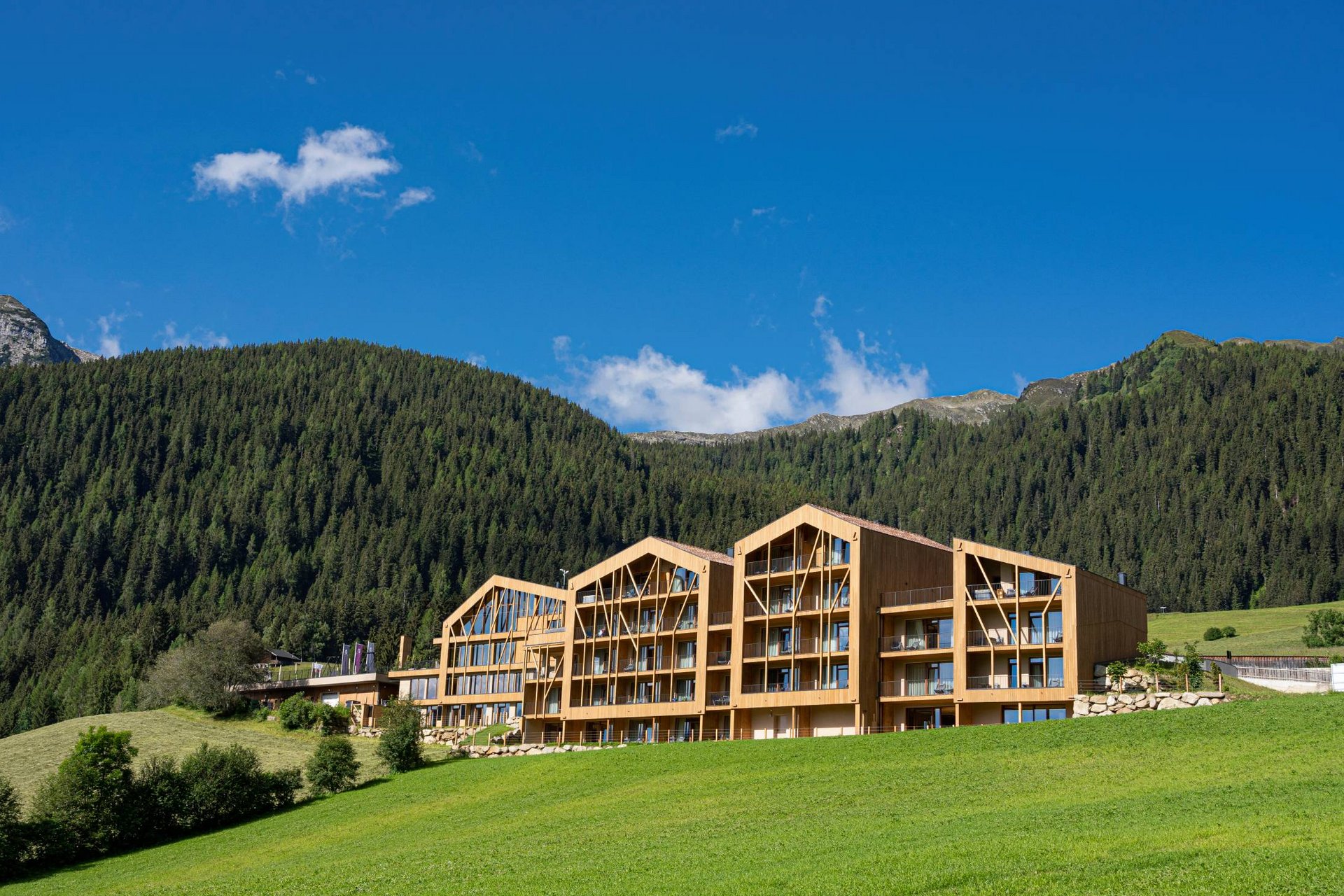
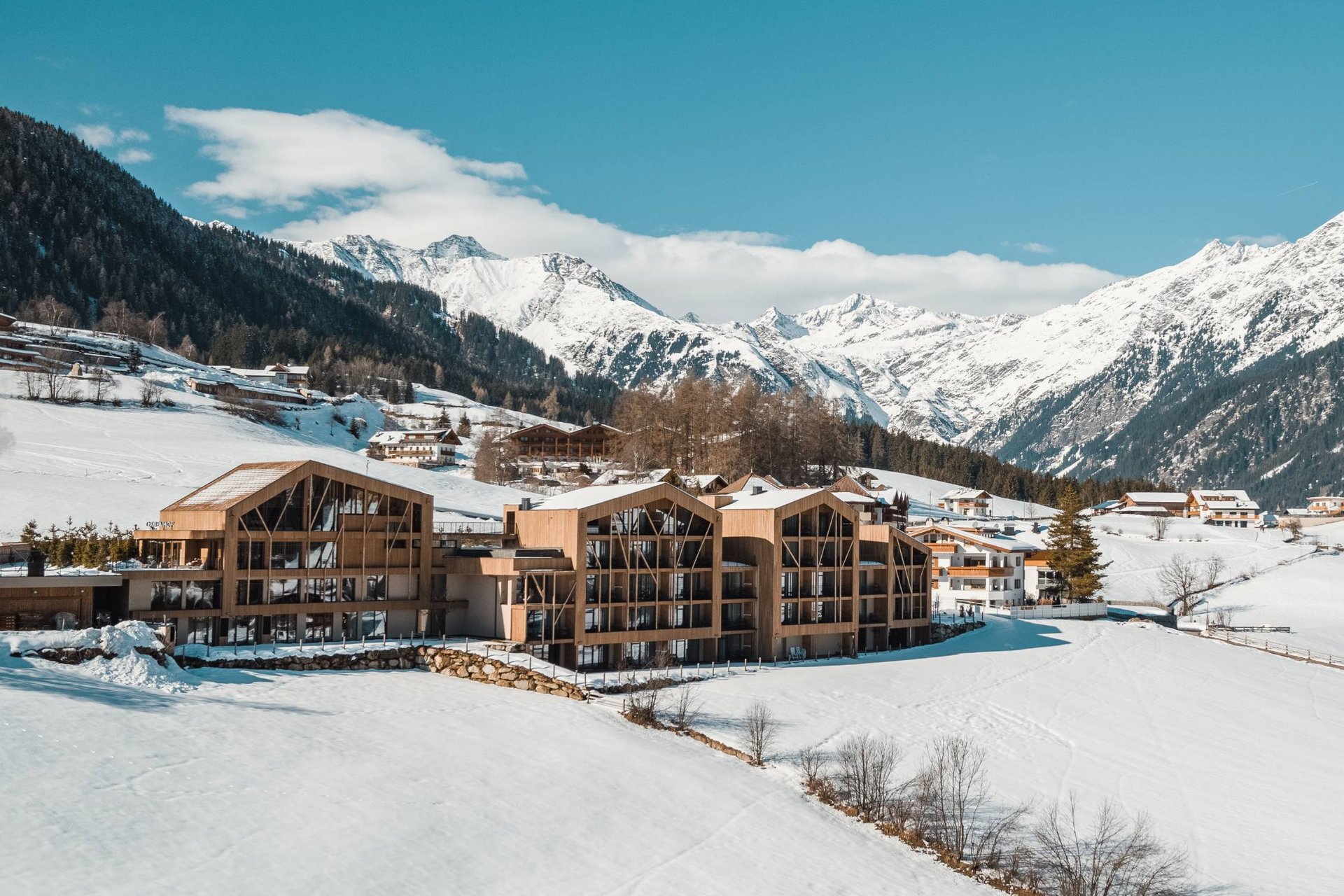
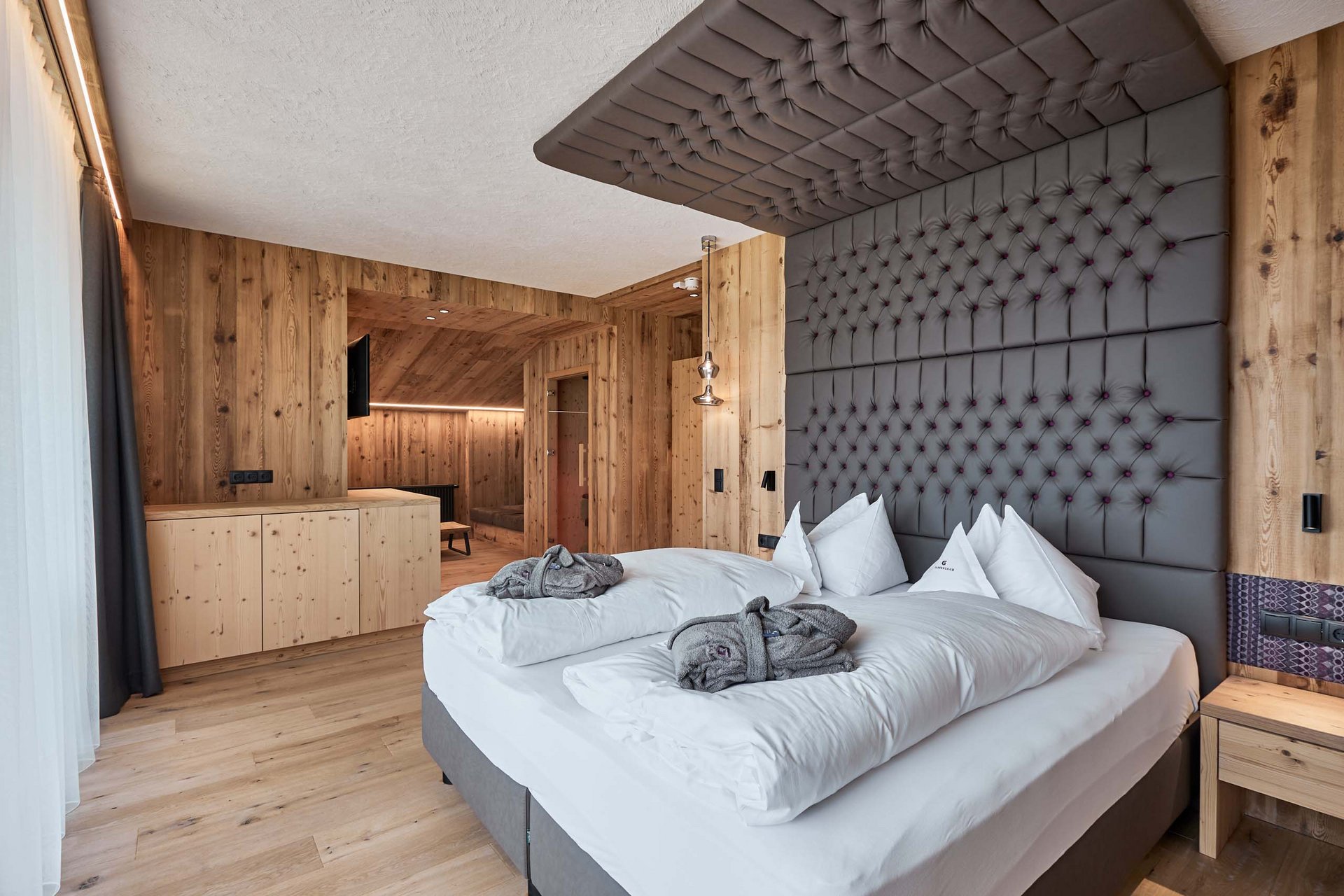
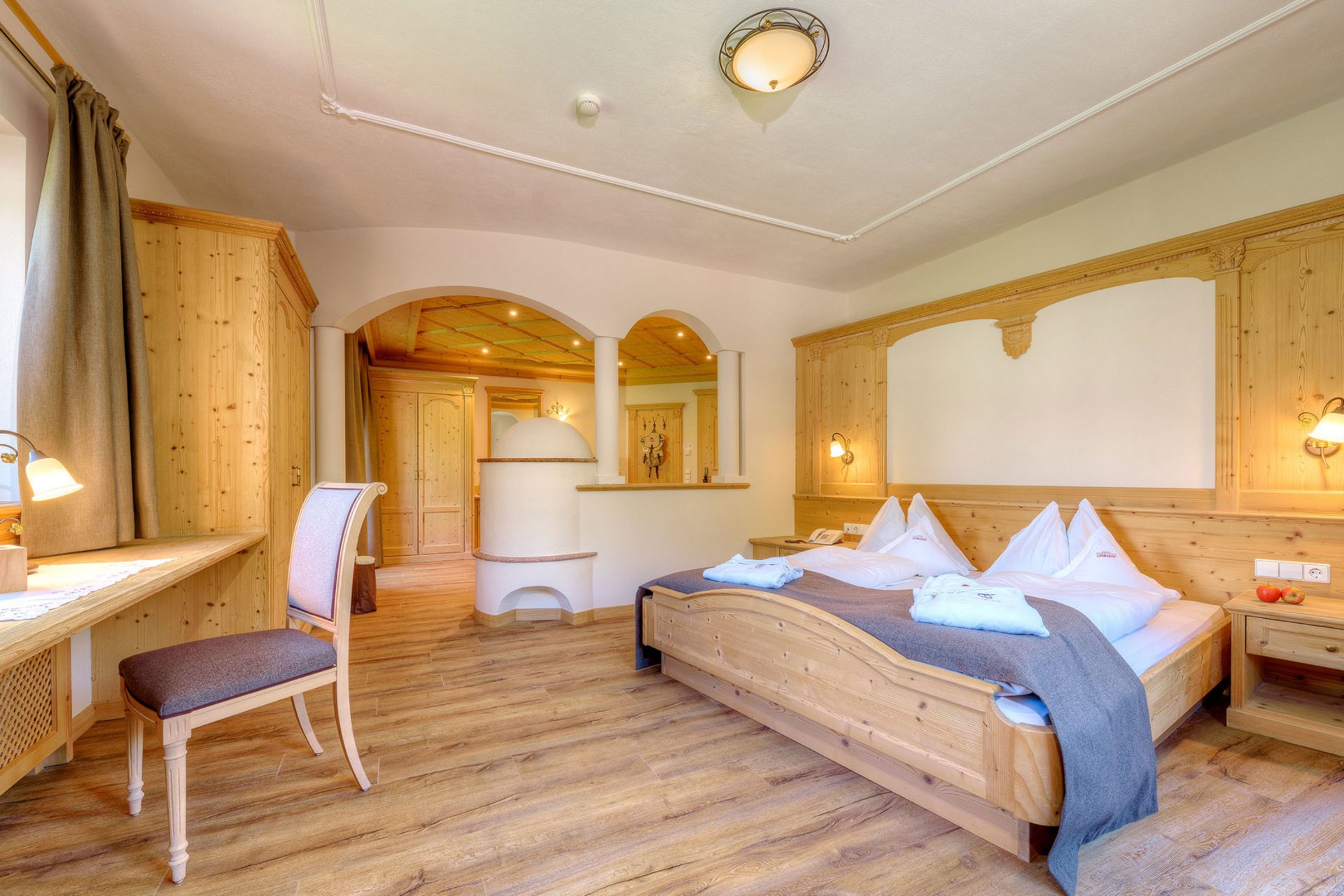


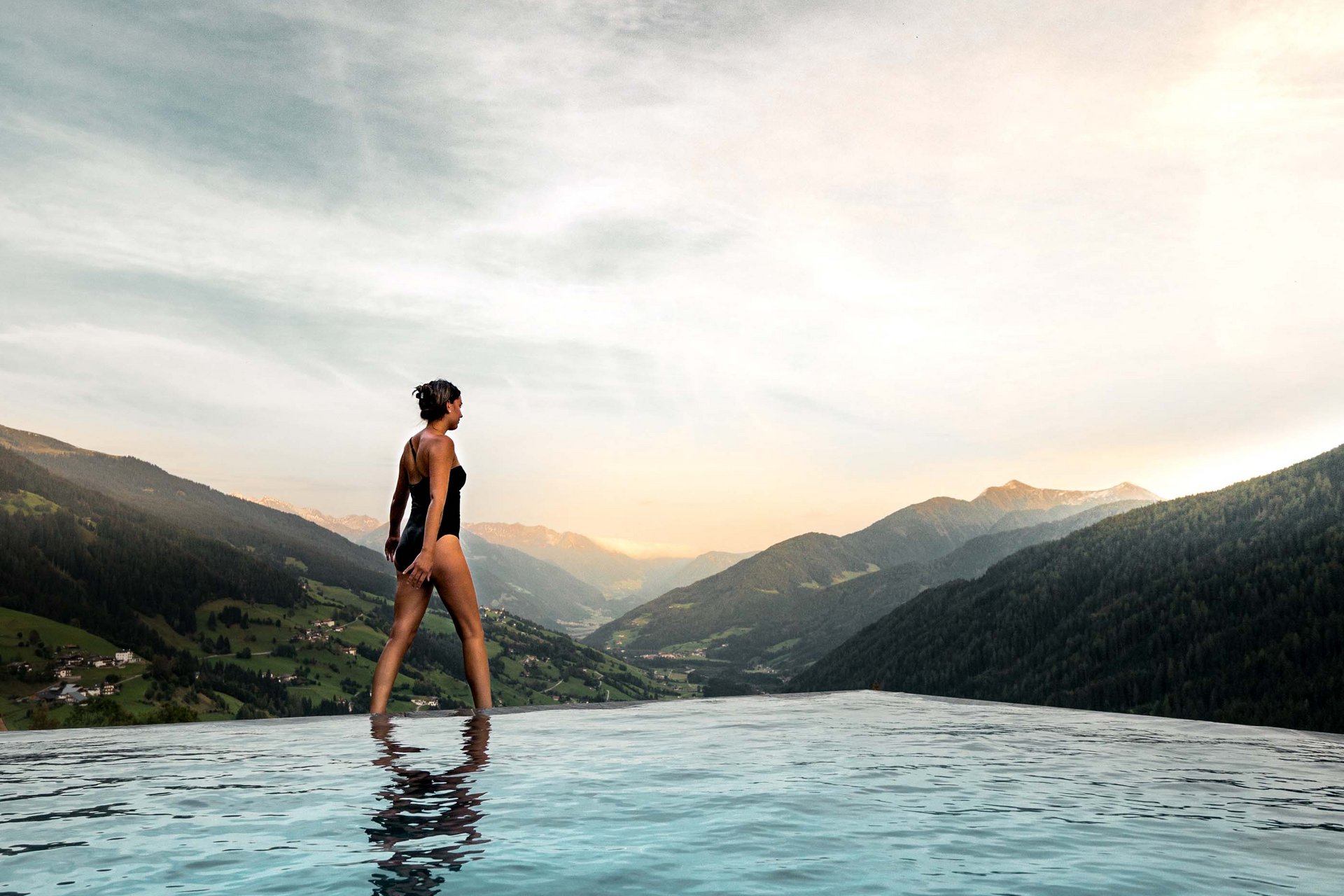
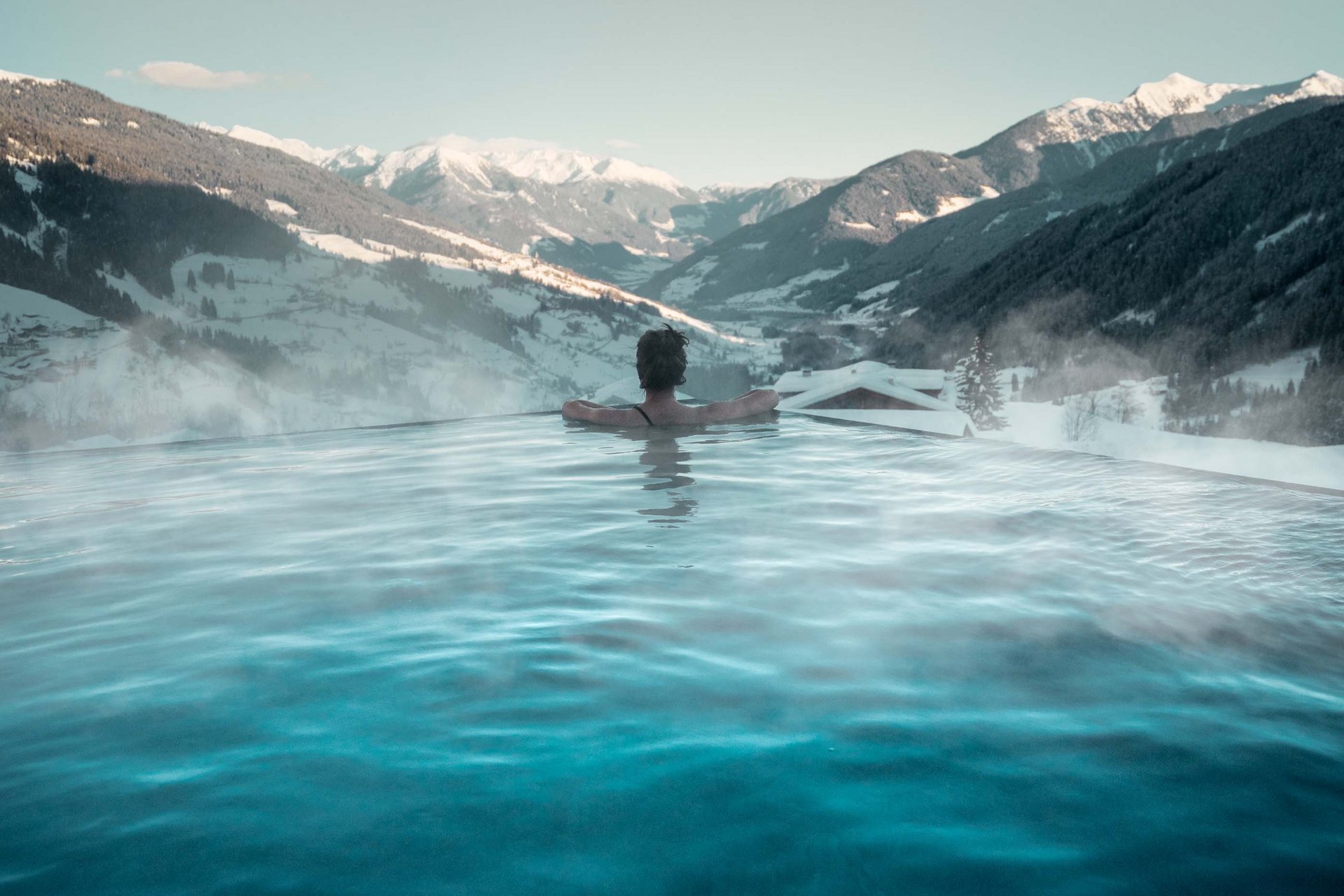
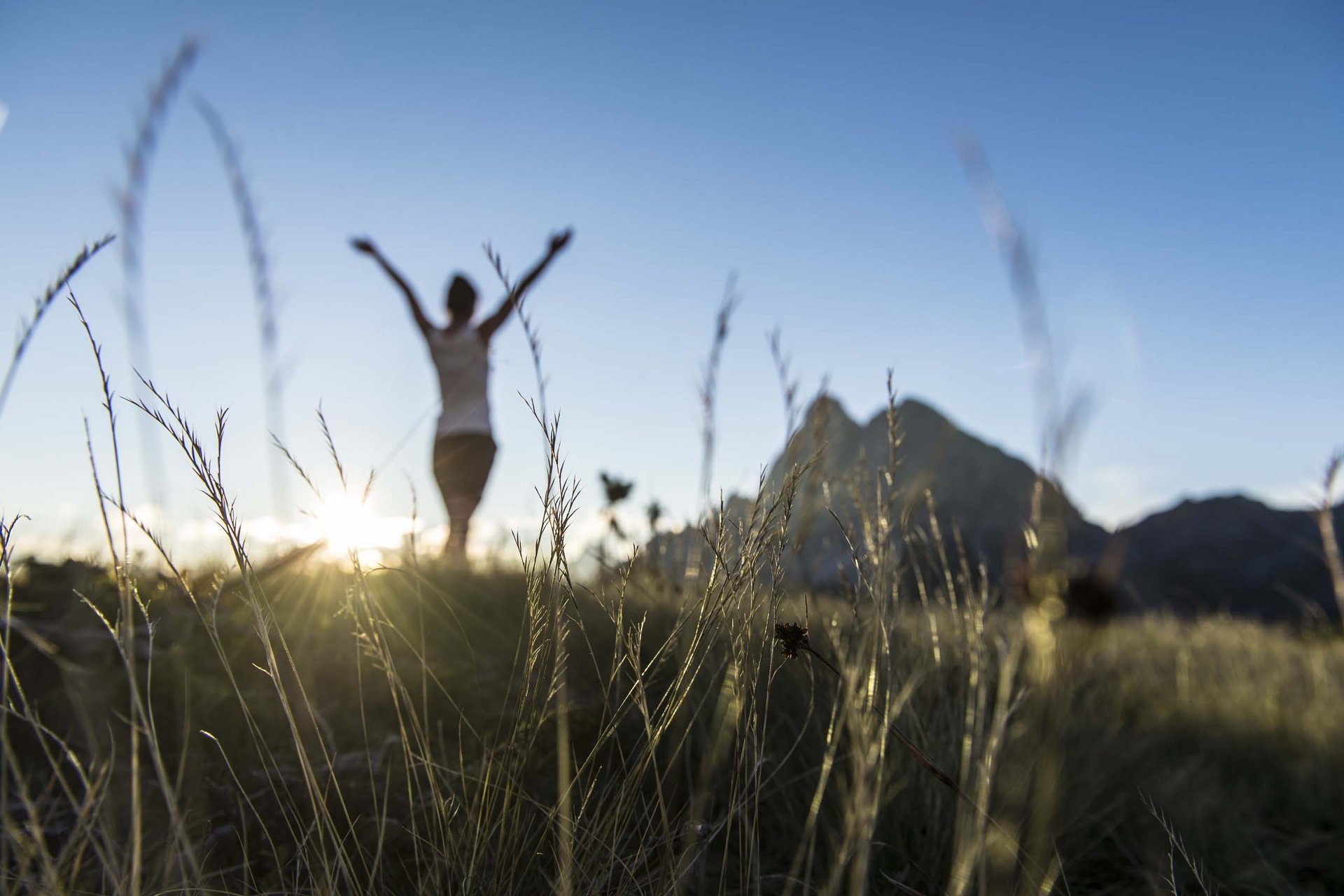
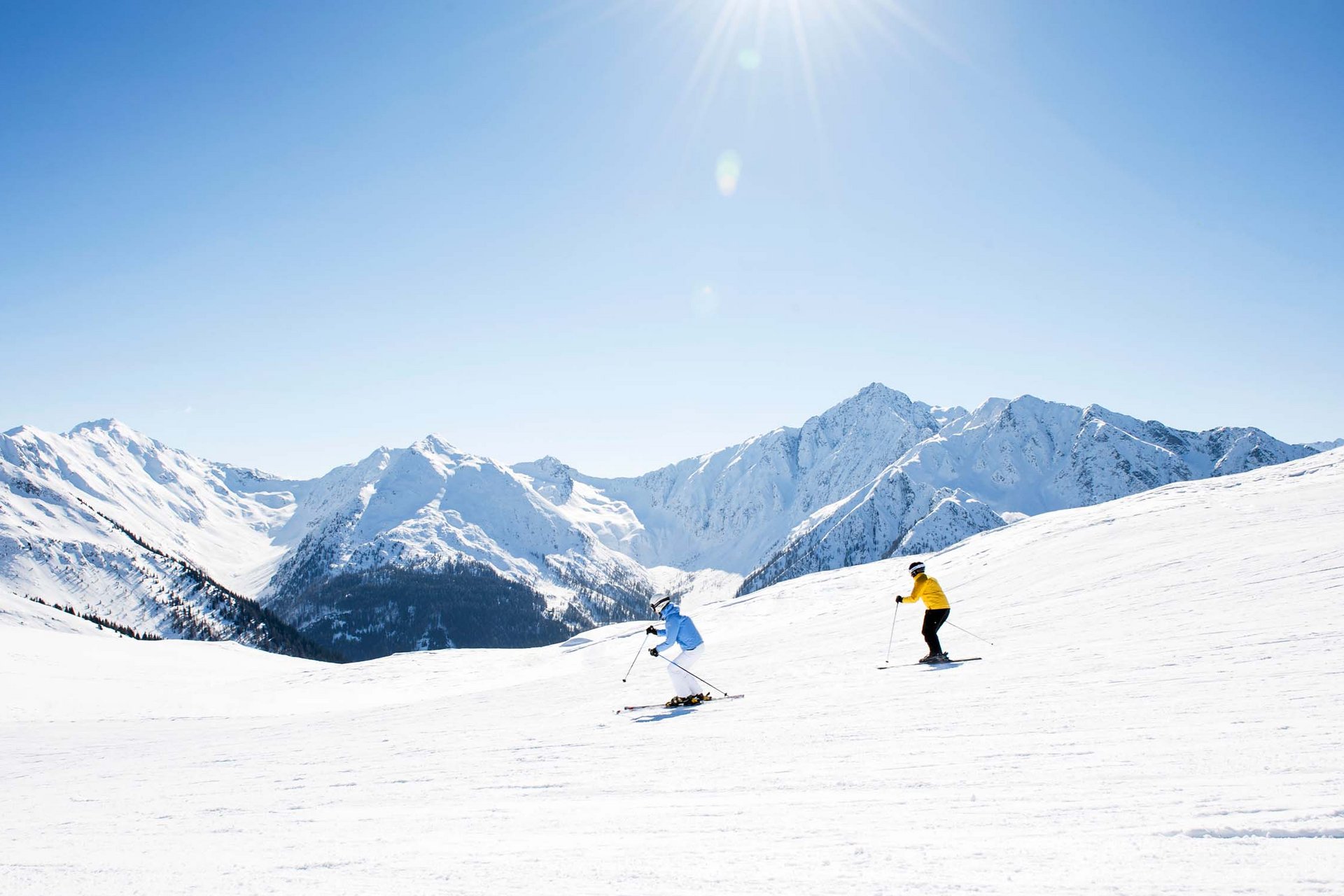
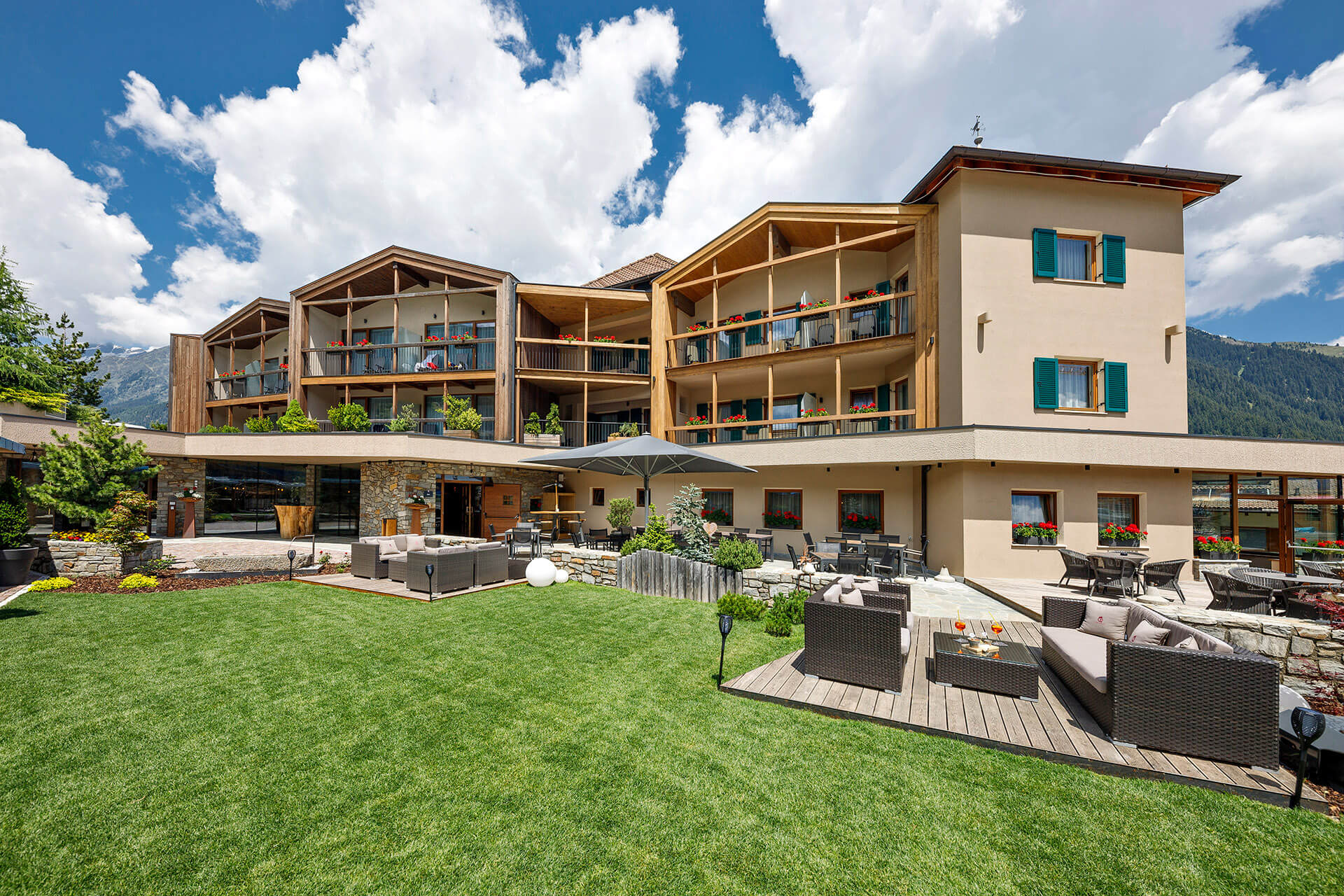
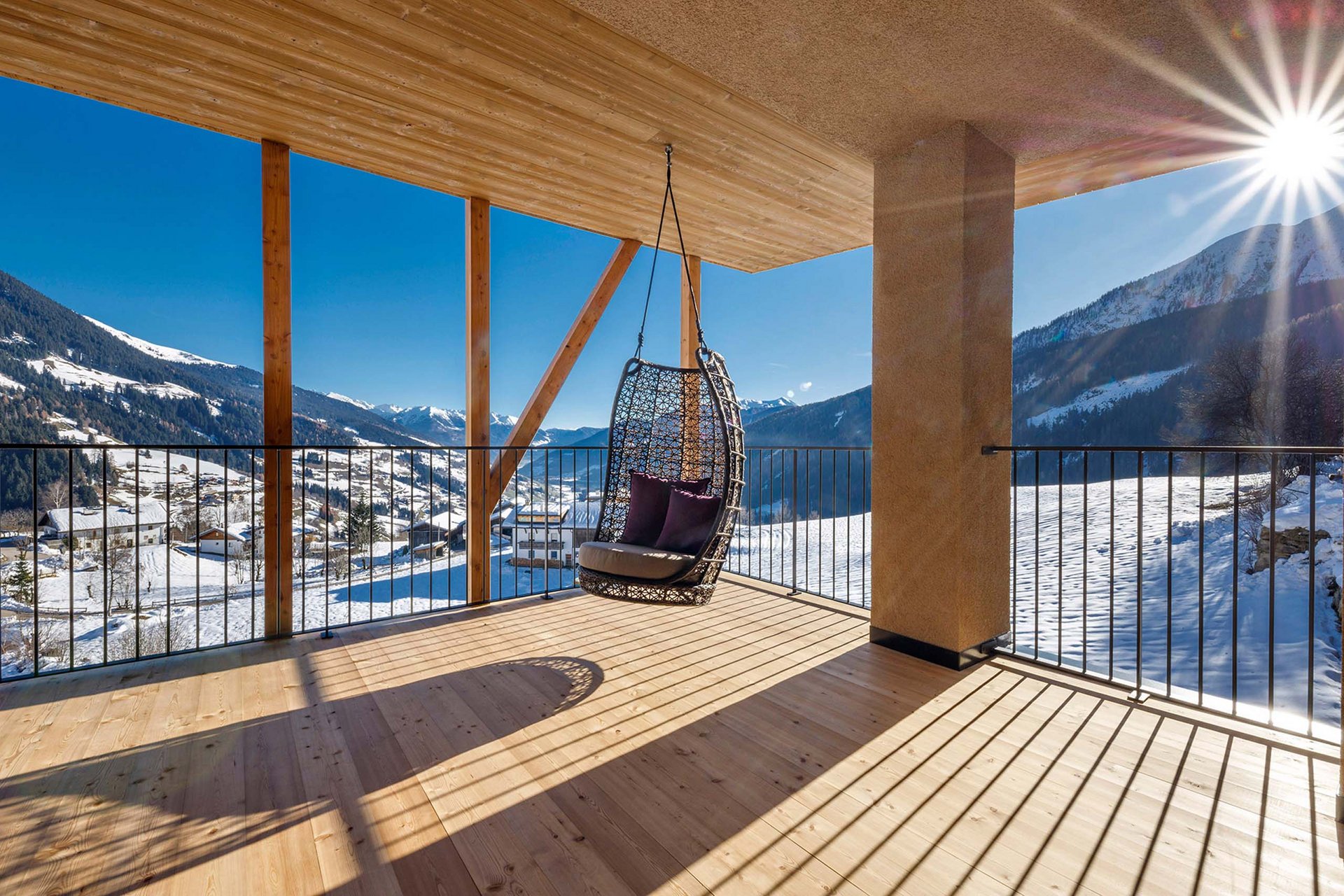
![[Translate to Englisch:] [Translate to Englisch:]](/fileadmin/_processed_/d/b/csm_WEBHotel-Gassenhof-Sommer-2020-1170623_55b37c05cc.jpg)
![[Translate to Englisch:] [Translate to Englisch:]](/fileadmin/_processed_/9/2/csm_gassenhof_neu-69_8a62f84800.jpg)
